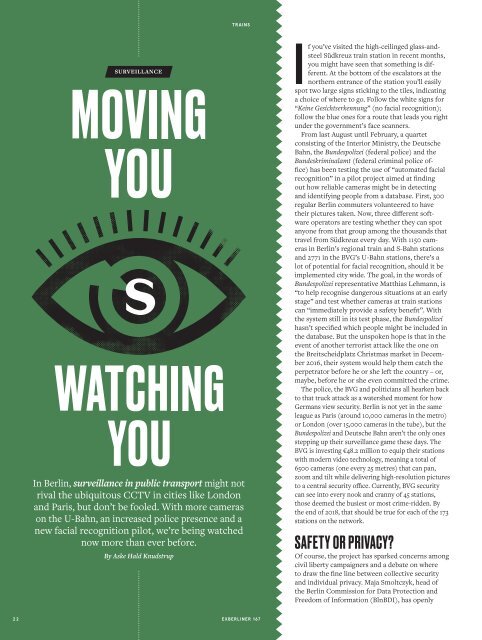Exberliner Issue 167, January 2018
You also want an ePaper? Increase the reach of your titles
YUMPU automatically turns print PDFs into web optimized ePapers that Google loves.
TRAINS<br />
SURVEILLANCE<br />
In Berlin, surveillance in public transport might not<br />
rival the ubiquitous CCTV in cities like London<br />
and Paris, but don’t be fooled. With more cameras<br />
on the U-Bahn, an increased police presence and a<br />
new facial recognition pilot, we’re being watched<br />
now more than ever before.<br />
By Aske Hald Knudstrup<br />
I<br />
f you’ve visited the high-ceilinged glass-andsteel<br />
Südkreuz train station in recent months,<br />
you might have seen that something is different.<br />
At the bottom of the escalators at the<br />
northern entrance of the station you’ll easily<br />
spot two large signs sticking to the tiles, indicating<br />
a choice of where to go. Follow the white signs for<br />
“Keine Gesichtserkennung” (no facial recognition);<br />
follow the blue ones for a route that leads you right<br />
under the government’s face scanners.<br />
From last August until February, a quartet<br />
consisting of the Interior Ministry, the Deutsche<br />
Bahn, the Bundespolizei (federal police) and the<br />
Bundeskriminalamt (federal criminal police office)<br />
has been testing the use of “automated facial<br />
recognition” in a pilot project aimed at finding<br />
out how reliable cameras might be in detecting<br />
and identifying people from a database. First, 300<br />
regular Berlin commuters volunteered to have<br />
their pictures taken. Now, three different software<br />
operators are testing whether they can spot<br />
anyone from that group among the thousands that<br />
travel from Südkreuz every day. With 1150 cameras<br />
in Berlin’s regional train and S-Bahn stations<br />
and 2771 in the BVG’s U-Bahn stations, there’s a<br />
lot of potential for facial recognition, should it be<br />
implemented city wide. The goal, in the words of<br />
Bundespolizei representative Matthias Lehmann, is<br />
“to help recognise dangerous situations at an early<br />
stage” and test whether cameras at train stations<br />
can “immediately provide a safety benefit”. With<br />
the system still in its test phase, the Bundespolizei<br />
hasn’t specified which people might be included in<br />
the database. But the unspoken hope is that in the<br />
event of another terrorist attack like the one on<br />
the Breitscheidplatz Christmas market in December<br />
2016, their system would help them catch the<br />
perpetrator before he or she left the country – or,<br />
maybe, before he or she even committed the crime.<br />
The police, the BVG and politicians all hearken back<br />
to that truck attack as a watershed moment for how<br />
Germans view security. Berlin is not yet in the same<br />
league as Paris (around 10,000 cameras in the metro)<br />
or London (over 15,000 cameras in the tube), but the<br />
Bundespolizei and Deutsche Bahn aren’t the only ones<br />
stepping up their surveillance game these days. The<br />
BVG is investing €48.2 million to equip their stations<br />
with modern video technology, meaning a total of<br />
6500 cameras (one every 25 metres) that can pan,<br />
zoom and tilt while delivering high-resolution pictures<br />
to a central security office. Currently, BVG security<br />
can see into every nook and cranny of 45 stations,<br />
those deemed the busiest or most crime-ridden. By<br />
the end of <strong>2018</strong>, that should be true for each of the 173<br />
stations on the network.<br />
SAFETY OR PRIVACY?<br />
Of course, the project has sparked concerns among<br />
civil liberty campaigners and a debate on where<br />
to draw the fine line between collective security<br />
and individual privacy. Maja Smoltczyk, head of<br />
the Berlin Commission for Data Protection and<br />
Freedom of Information (BlnBDI), has openly<br />
22<br />
EXBERLINER <strong>167</strong>


















